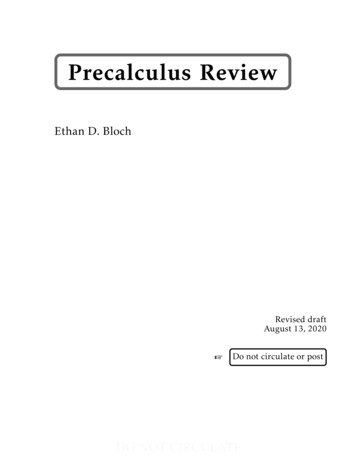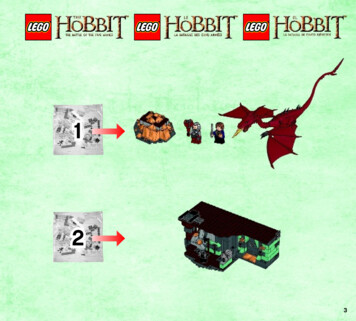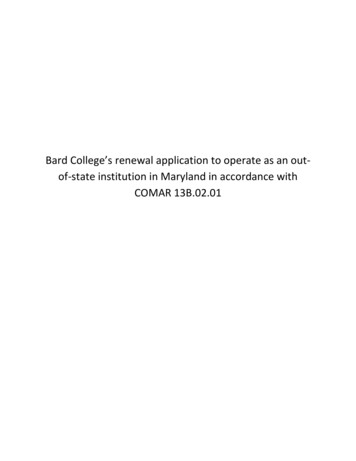
Transcription
Precalculus ReviewEthan D. BlochRevised draftAugust 13, 2020 Do not circulate or postDO NOT CIRCULATE
2DO NOT CIRCULATE
Contents1.11.21.31.41.51.61.71.8Algebra . . . . . . . . . .Functions and Graphs . .Linear Functions . . . . .Polynomials . . . . . . .Power Functions . . . . .Trigonometric FunctionsExponential Functions .Logarithmic Functions .3DO NOT CIRCULATE.410172023263336
4CONTENTS1.1AlgebraCalculus makes use of precalculus—hence the name of the latter—but to do precalculus, a solid knowledgeof basic algebra is needed. We review here a few of the most important ideas from algebra that are neededfor calculus.Types of NumbersPrecalculus, and calculus, takes place within the context of the real numbers. Within the real numbers,there are some import special types of numbers that are frequently used in mathematics.Types of Numbers1. The real numbers, denoted R, are all the numbers on the number line, including positive num bers, negative numbers, zero, whole numbers, fractions, and all other numbers (such as 2and π).2. The rational numbers, denoted Q, are all numbers that are expressible as fractions, for example23 or 0.5.3. The integers, denoted Z, are the numbers 4, 3, 2, 1, 0, 1, 2, 3, 4, . . .4. The natural numbers, also called the positive integers, denoted N, are the numbers 1, 2, 3, 4, . . .Note that all natural numbers are integers, and all integers are rational numbers, and all rational numbers are real numbers, but not the other way around.A collection of numbers that is even larger than the set of real numbers is the set of complex numbers,denoted C. It is not assumed that the reader is familiar with the complex numbers. These numbers are notused in Calculus I and Calculus II; they do arise in Introduction to Linear Algebra and Ordinary DifferentialEquations, and they will be discussed there.InfinityWe will, at times, be using the symbols and to denote “infinity” and “negative infinity,” respectively.These words are written in quotes to emphasize the following. Error Warning The symbols and are not numbers. These symbols represent what happens as we take numbers that get larger and larger without bound (going to ) and get smaller andsmaller (meaning negative numbers having larger and larger magnitude).For example, the numbers 2, 4, 8, 16, 32, . . . are “going to ,” and the numbers 1, 3, 5, 7, 9, . . . are“going to .”DO NOT CIRCULATE
1.1. ALGEBRA Error Warning“ 5”).5Do not try to use the symbols and in algebraic expressions (for exampleIntervalsIntervals are a very useful type of collections of real numbers. An interval is the set of all numbers betweentwo fixed numbers, where the endpoints might or might not be included in the interval. The different typesof interval are as follows.IntervalsLet a and b be real numbers. Suppose that a b.Notation(a, b)[a, b][a, b)(a, b](a, )( , b)( , )[a, )( , b]Type of Intervalopen bounded intervalclosed bounded intervalhalf-open intervalhalf-open intervalopen unbounded intervalopen unbounded intervalopen unbounded intervalclosed unbounded intervalclosed unbounded intervalDefinitiona x ba x ba x ba x ba xx ball real numbersa xx bFor example, the interval [2, 5] is the set of all real numbers x such that 2 x 5. The interval (3, ) isthe set of all real numbers x such that 3 x. Error Warning The notation (a, b), for example (1, 6), is used to mean different things in mathematics. In the present context the notation (1, 6) means the interval from 1 to 6, not including theendpoints. On the other hand, when discussing points in the plane (usually denoted R2 ), the notation (1, 6) means the point in R2 with x-coordinate 1 and y-coordinate 6. The fact that the samemathematical notation can mean very different things in different contexts can be confusing, but itis a historical accident with which we are now stuck. Fortunately, the meaning of notation such as(a, b) can usually be figured out from the context. Error Warning The symbols and are not numbers, and cannot be included in an interval.Hence, there is no interval of the form “[2, ].”Absolute ValueA very useful function for working with numbers is the absolute value function, which is defined as follows.DO NOT CIRCULATE
6CONTENTSAbsolute ValueLet x be a real number. The absolute value of x, denoted x , is defined by if x 0 x, x x, if x 0.The absolute value function has a number of very nice properties, including the following.Absolute Value: PropertiesLet x, y and b be real numbers.1. x x .4. xy x y .2. x 2 x2 .5. x b if and only if b x b.3. x y y x .Basic Algebra FormulasThere are a few basic algebra formulas involving multiplying and factoring simple polynomials that willbe useful throughout calculus.Basic Algebra FormulasLet a and b be real numbers.1. (a b)2 a2 2ab b2 .3. (a b)(a b) a2 b2 .2. (a b)2 a2 2ab b2 .There are also formulas for expressions such as (a b)3 that are useful on occasion, though there is noneed to remember such formulas, because they can be looked up, or worked out as needed. For example,the expression (a b)3 can be computed by rewriting it as (a b)2 (a b), using the formula for (a b)2 , andmultiplying the resulting polynomials.Solving Quadratic EquationsSolving quadratic equations is needed on occasion in calculus. Such equations can be solved in some casesby factoring (which is the quicker method when it works), and in all cases by the quadratic formula. Exceptfor a few situation involving differential equations, we are generally interested only in solutions of equations that are real numbers, not complex numbers. We note that not every quadratic equation has solutionsthat are real numbers.DO NOT CIRCULATE
1.1. ALGEBRA7Solving Quadratic EquationsThere are two methods to solve the equation x2 bx c 0.1. If numbers r and s can be found such that r s b and rs c, then x2 bx c (x r)(x s), andthe roots of x2 bx c 0 are x r and x s. b b2 4ac22. The roots of ax bx c 0 are x , provided b2 4ac 0.2aFractions and Rational ExpressionsA elementary topic that is needed for calculus, and that, for whatever reason, is something that not everystudent of calculus knows sufficiently well, is the addition, subtraction, multiplication and division offractions. Specifically, for calculus we need to add, subtract, multiply and divide fractions that involveletters as well as numbers, and fractions that have fractions in their numerators and denominators.One of the key idea to keep in mind in algebra is that letters in algebra simply stand for numbers thatwe don’t know their values, and we therefore treat letters exactly the same as we would treat numbers.In particular, the familiar rules for adding, subtracting, multiplying and dividing fractions with numberswork just as well for fractions with letters, and for built-up fractions.One other thing to keep in mind is that when dealing with built-up fractions, which have fractionsin their numerators and/or denominators, it is important to distinguish the main fraction line from thesubsidiary fraction lines. Visually, the best way to make this distinction is to write the main fraction linelonger than the other fraction lines. Even better, the main fraction line should be written not only longerthan the other fraction lines, but should be written level with the equals sign.There are three particular types of built-up fractions that can cause confusion, and which we examine.The way to simplify these types of fractions should not be memorized. Rather, all such fractions should besimplified using the basic rules for adding, subtracting, multiplying and dividing fractions.1. Simplifyab.cThis fraction can be simplified by rewriting the denominator as 1c , yieldingabc2. Simplifyabc abc1 a 1a· .b c bc.This fraction can be simplified by rewriting the numerator as 1a , yieldingabc a1bc a c ac· .1 bb dc.eThis fraction can be simplified by first adding the two fractions in the numerator, and then using themethod of Item 1, yielding3. Simplifyabab dc ead bcbde ad bcbde1 ad bc 1 ad bc· .bdebdeDO NOT CIRCULATE
8CONTENTSThe following two examples are both used in calculus.Example 1Simplify1x h 1x.hSolutionWe compute 1x h1x hx (x h)x(x h)h hx(x h)h1 11 h· .x(x h) hx(x h)Example 2 Simplify x h x.hSolutionHere we use a little trick, which is (x h) xx h xx h xx h x · hhx h x h( x h x)h1 .h( x h x)x h x The expression x h x, whichin order to remove the square roots in the numerator, is is used referred to as the “conjugate” of x h x.EXERCISES1–4Multiply and then simplify each expression.1. (3x 5)(x2 2x 4)5–8Multiply and then simplify each expressionby using basic formulas.2. (2m 3n)(3m2 5mn n2 )5. (5a 3)26. (3m 4n)23. (2y 1)(y 5)(3y 4)7. (5y 1)(5y 1)8. (2s2 t)(2s2 t)4. 5p2 (p 3)(3p2 4)DO NOT CIRCULATE
1.1. ALGEBRA9–12mulas.9Factor each expression by using basic for-9. x2 8x 1610. 4m2 12mn 9n211. z2 4912. 9y 4 16x6Solve each equation.17–2017. x2 2x 8 018. x2 10x 25 019. x2 5x 3 020. 3x2 x 5 0Simplify each expression21–2413–16Factor each quadratic.13. x2 9x 2014. x2 3x 2815. 2x2 7x 316. 6x2 11x 1032 122. a4 12221. x6ax511 23. n 15 n 2n 1 31 1(x h)2 x2hSolve each equation.25–2825.24.x2 2x 3 03x2 6x 1553 x 027. x 27 1x 2 xDO NOT CIRCULATE26.x2 x 6 0x2 41 125228. x 0x 5
10CONTENTS1.2Functions and GraphsFunctions are the main ingredient in calculus. The two main things we do in calculus, namely, derivativesand integrals, and things that are done to functions.Functions are also a unifying approach in mathematics. For example, whereas logarithms and trigonometry seem to be very different, what we are interested in here is logarithmic functions and trigonometricfunctions, and, even though these two types of functions arise from very different considerations, as functions we treat them just as we do any other functions.One thing to keep in mind about functions is that it is not correct to think of functions simply asformulas, for example f (x) x2 . Whereas it is true that many useful functions are given by formulas,there are also useful functions that are not given by single formulas, not to mention functions not given byformulas at all. The most basic idea of a function is that it takes some sort of object as input (in calculus theinput is numbers or vectors, though other types of input are used elsewhere), and for each possible input,there is one and only one output.There are different ways of representing functions, including1. Verbally2. Numerically (table of values)3. Graphically4. By formula (some says “algebraically,” but that isn’t correct).All these methods of describing a function are equivalent, and it is important to be able to go from onemethod to the other, for example to go from formula to graph and vice-versa.Domain of a FunctionEvery function can take certain things as inputs. For example, the function f (x) defined by the formulaf (x) x2 can take all real numbers as inputs, whereas the function g(x) defined by the formula g(x) ln xcan take only positive real numbers as inputs.In our present context, we are considering functions with real numbers as inputs, and we then have thefollowing concepts.Domain and RangeLet f (x) be a function with real numbers as inputs.1. The domain of f (x) is the set of all possible real numbers for which the function produces anoutput.2. The range of f (x) is the set of all outputs of the function, when everything in the domain off (x) is substituted into the function.The range of a function can be useful in some contexts, though for our purpose the domain is the muchmore important concept.In more advanced mathematics, the concept of the domain of a function, which takes on even moreimportance, is slightly more general than we are using here.DO NOT CIRCULATE
1.2. FUNCTIONS AND GRAPHS11There is no definitive method for finding the domain of a function. However, there are a few thingsto keep in mind. For example, because it is not possible to divide by zero, we exclude anything from thedomain that would lead to dividing by zero. Hence, the domain of the function defined by the formula1f (x) is the set of all real numbers other than 2.x 2Other standard considerations when finding the domain of a function is that we cannot take the squareroot of a negative number (we are considering only real numbers here); we cannot take the logarithms of aπ 3π, etc.negative number or zero; and we cannot take the tangent of ,2 2Substituting Numbers and Expressions into FunctionsThe point of a function is that we put things into it, and get something out of it for each thing we put intoit. For example, let f (x) be the function defined by the formula f (x) x2 . Clearly, if we put 3 into thefunction, we get f (3) 9 as the output. It can certainly happen that different inputs produce the sameoutput. For example, we note that f ( 3) 9 for this function. The crucial thing to observe is that a singleinput produces a single output. For example, let g(x) be the function defined by the formula g(x) x. First, we observe that the domain of g(x) is the set of all non-negative numbers. More importantly, we note that when we write x, we meanonly the positive square root of x. For example, we have g(4) 2. It is certainly true that 2 is also a squareroot of 4, but we cannot say that g(4) is 2, because that would give us two outputs for the single input 4. Hence, we use the standard convention that x always means the positive square root of x. If we want toobtain the negative square root of a number, we would need a different function, namely, the function h(x) defined by the formula h(x) x.For calculus, we need to substitute not only single numbers into functions, but also more complicatedexpression. For example, let f (x) be the function defined by the formula f (x) x2 . Then we will need tocompute the expression f (x h), which is given byf (x h) (x h)2 x2 2xh h2 . Error Warning In the above example, it is important to recognize that f (x h) is not the sameas f (x) h, which would be x2 h. That is, when we add h to x “inside” the function, that is not thesame as adding h to the “outside” of the function.Graphs of FunctionsJust as a person can be encountered in different ways (for example, in person, by phone, by email, on socialmedia), so too can a function be seen in different ways. One way of describing a function is via a formula, forexample the function f (x) defined by the formula f (x) x2 . Another way of describing the same functionis visually, via its graph.The graph of a function of the form y f (x) is the subset of the plane consisting of all points (a, b) thatsatisfy the equation f (a) b.For example, for the function f (x) defined by the formula f (x) x2 , the point (3, 9) is in the graph ofthe function, because f (3) 32 9.To find all the points on the graph of a function, the most direct method would be to take every numberin the domain of the function and put it into the function to find the output, and then plot all the pointsobtained in this way. Of course, doing that is not physically possible, because are infinitely many realnumbers. Nonetheless, we can figure out what the graphs of many functions looks like. For example, thegraph of the function f (x) defined by the formula f (x) x2 is seen in Figure 1 of this section.DO NOT CIRCULATE
12CONTENTS4321-21-12-1-2Figure 1: Graph of f (x) x2 Error Warning There are a number of useful things to do when graphing functions, some ofwhich you will learn in calculus, and there is one thing you should definitely not do when you grapha function: finding the value of the function at a few values of x, plotting those points in the plane,and “connecting the dots.” If you could plot hundreds of very close points, you would likely have agood approximation of the graph (that’s how computers plot graphs), but plotting a large number ofpoints by hand is not practical, and plotting just a few points is not a good way to obtain an accuratepicture of what the graph actually looks like, because the few points that were plotted might missthe important features of the graph. The way to plot a graph is to know what the graph oughtto look like, which means to use the basic graphs that you know (lines, quadratics, trigonometricfunctions, exponentials, logarithms, etc.), and then modify those basic graphs, and, once you knowsome calculus, to use that to obtain much more information about graphs.In the same way that anyone learning a new language needs to know some basic vocabulary and grammar by heart without having to consult a dictionary, anyone who studies calculus should know the graphsof some basic functions—without a calculator! These functions will be identified in the subsequent sectionsof this chapter, starting with a few given below.Finally, we note that whereas the graph of every function of the form y f (x) is a curve in the plane, notevery curve in the plane is the graph of a function. For a curve in the plane to be the graph of a function,each value of x can have either one point on the curve (if that x is in the domain of the function) or no pointon the curve (if that x is not in the domain). In other words, every vertical line in the plane can intersectthe curve either once or not at all; any curve that satisfies this condition with regard to vertical lines is saidto pass the vertical line test, and is the graph of a function.For example, a parabola which has the x-axis as its line of symmetry does not satisfy the vertical linetext, and hence is not the graph of a function, whereas a parabola that has the y-axis as its line of symmetrydoes satisfy the vertical line text, and hence is the graph of a functionGraphs You Should KnowGraphs you should know: y c, and y x, and y x and y x .DO NOT CIRCULATE
1.2. FUNCTIONS AND GRAPHS13Basic Graphs1. y c2. y x3. y x4. y x New Graphs from OldOne of the main methods of graphing functions is to do so by modifying the graphs of familiar functions.There are a number of such modifications, which are summarized as follows.New Graphs from OldLet f (x) be a function, and let c be a positive real number.DO NOT CIRCULATE
14CONTENTSFunctiony f (x c)y f (x c)y f (x) cy f (x) cy cf (x)y f (cx)y f (x)y f ( x)Type of Modificationshift the graph of y f (x) to the left by c unitsshift the graph of y f (x) to the right by c unitsshift the graph of y f (x) upward by c unitsshift the graph of y f (x) downward by c unitsstretch the graph of y f (x) vertically by a factor of cstretch the graph of y f (x) horizontally by a factor of creflect the graph of y f (x) in the x-axisreflect the graph of y f (x) in the y-axisOf course, the various types of modifications listed above can be combined.Example 1Sketch the graph of y 2 x 1 3.SolutionAs seen in the following figures, we sketch this graph in steps, starting with the graphof y x , and then doing one modification of the graph at a time until we obtain the desired result.1. y x 2. y x 1 3. y 2 x 1 4. y 2 x 1 DO NOT CIRCULATE
1.2. FUNCTIONS AND GRAPHS155. y 2 x 1 3Functions Defined PiecewiseWhereas many commonly used functions are defined by a single formula, for example the function f (x)defined by the formula f (x) x2 , there are many functions that arise in mathematics and its applicationsthat are defined in pieces, rather than by a single formula.For example, let g(x) be the function defined by the formula 2 x , if x 0g(x) x, if x 0.This function g(x) is defined for all real numbers x, and is well-defined, because there is a unique outputfor each input, due to the fact that the two parts of the function are defined on intervals that do not overlap.The above function is and example of a function that is defined piecewise. Of course, a function that isdefined piecewise can be defined in more than two parts; any number of parts is acceptable.The graphs of functions that are defined piecewise are made by simply graphing each piece on the partof the real numbers for which it is defined. We use a solid dot to indicate the end of a piece of the graphwhere the graph is actually defined, and a hollow dot to indicate the end of a piece of the graph where thegraph is not defined.EXERCISES1–4Find the domain of each function.13 x 2 x2 9p3. h(x) x2 161. f (x) 2. g(x) ln(x 3)14. y x 35–8Let f (x) be the function defined by the formula f (x) x2 . Find and simplify each of the following expressions.5. f (x 2)6. f (x h) f (x h)7. f (x a b)8.DO NOT CIRCULATEf (x h) f (x)h
16CONTENTS9–12Sketch the graph of each function,where the graph of y f (x) is seen below.13–16Sketch the graph of each function.13. y x 2 14. y x 215. y 2 x 3 16. y x 1Sketch the graph of each function. 2 x 1, if x 017. y x,if x 0.17–20 x 3 , if x 118. y 5x2 ,if x 1.9. y f (x 3)10. y f (x) 211. y 2f (x)12. y 2f (x 1) 3 if x 1 3, 19. y x,if 1 x 1 3, if x 1. π sin x, if x 2 π20. y tan x, if π 2 x 2 π cos x, if x .2DO NOT CIRCULATE
1.3. LINEAR FUNCTIONS1.317Linear FunctionsLinear functions appear throughout mathematics and the application of mathematics in the sciences andsocial sciences. In particular, linear functions play a crucial role in calculus, because the derivative of afunction is just the slope of the tangent line at each point of the graph of the function.Linear functions are functions whose graphs are straight lines. It is assumed that you are familiar withstraight lines from a geometric point of view.Whereas straight lines exist in both the plane and three-dimensional space (and higher-dimensionalspace as well), at present we are concerned only with lines in the plane.It is very important to distinguish between all lines in the plane on the one hand, and lines that aregraphs of functions on the other hand. The difference between these two types of lines is that lines that aregraphs of functions cannot be vertical.Slope and y-interceptA straight line in the plane that is the graph of a function has two significant numbers associated with it,namely, the slope and the y-intercept, which are defined as follows.Slope and y-intercept1. Let (x0 , y0 ) and (x1 , y1 ) be points. Suppose x0 , x1 . The slope of the line containing (x0 , y0 ) andy y(x1 , y1 ) is m 1 0 .x1 x02. The y-intercept of a line is the value of y where the line intersects the y-axis.The important thing to observe about the definition of the slope of a line is that no matter which twoy ypoints on the line (x0 , y0 ) and (x1 , y1 ) are chosen, the ratio m 1 0 will always be the same, which meansx1 x0that the slope of a line is well-defined. That would not be true for any curve other than a straight line.The slope of a line measures how “slanted” the line is. For example, a slope of 0 means that the line ishorizontal; a slope of 1 means that the line makes an angle of 45 with the positive x-axis; and a slope of 1 means that the line makes an angle of 45 with the negative x-axis.Equation of a LineAny line in the plane, whether vertical or not, can be given by an equation in x and y. There is a generalform of the equation of a line that includes all lines, and then there are special forms for vertical lines andnon-vertical lines.Equation of a Line1. The general form for the equation of a line is ax cy d.2. The equation of a vertical line has the form x p.3. The equation of a non-vertical line has the form y mx b, where m is the slope of the line andDO NOT CIRCULATE
18CONTENTSb is the y-intercept of the line.Finding the Equation of a LineFrom a geometric perspective, we need two points to determine a line. From an algebraic perspective, weneed two pieces of information to determine the equation of a line; those two pieces of information can bethe slope of the line and one point that is contained in the line, or they can be two points that are containedin the line.Finding the Equation of a Line1. Let m be a number and let (x0 , y0 ) be a point. To find the equation of the line with slope m thatcontains (x0 , y0 ), substitute (x0 , y0 ) into the equation y mx b, solve for b, and substitute theresult into y mx b.2. Let (x0 , y0 ) and (x1 , y1 ) be points. Suppose x0 , x1 . To find the equation of the line that containsy y(x0 , y0 ) and (x1 , y1 ), let m 1 0 , substitute m into the equation y mx b, substitute (x0 , y0 )x1 x0into the equation y mx b, solve for b, and substitute the result into y mx b.Parallel and Perpendicular LinesIn the plane, two lines are parallel if they do not intersect, and they are not parallel if they do intersect.Intuitively, if two lines are parallel, then they “go in the same direction.” More formally, we can use slopeto determine if two lines are parallel, and also when two line are perpendicular.Parallel and Perpendicular LinesLet y mx b and y nx c be lines.1. The two lines are parallel if and only if m n.12. The two lines are perpendicular if and only if m .nExample 1Find the equation of the line containing the point (9, 11) that is perpendicular to the line 6x 10y 7.7First, we solve for y in the equation of the given line, obtaining y 35 x 10. We deduce3that the slope of this line is n 5 . The line whose equation we want to find is perpendicular to that1line, and hence the slope of the line whose equation we want to find is m 3 53 . 5SolutionDO NOT CIRCULATE
1.3. LINEAR FUNCTIONS19The equation we want to find has the form y mx b. Using the value of m that we found above,we see that this equation is y 35 x b. We now substitute (x, y) (9, 11) into that equation, whichyields 11 53 · 9 b. Solving for b we obtain b 4. Hence the desired equation is y 53 x 4.EXERCISES1–4Find the equation of each line.1. The line containing the point (1, 2) that has slope32. The line containing the point (5, 0) that has slope 23. The line containing the point (2, 1) that is parallelto the line y 5x 34. The line containing the point (3, 2) that is perpendicular to the line y 2x 15–8Find the equation of the line containing eachpair of points.5. (1, 2) and (3, 8)6. (2, 1) and ( 5, 6)7. (3, 4) and ( 2, 4)8. (4, 2) and (4, 1)9–12For each pair of lines, state whether they areparallel, perpendicular or neither.9. y 2x 5 and 6x 3y 410. y 3x 4 and x 3y 1 011. x 4y 2 0 and 2x 6y 512. y 7 and x 2DO NOT CIRCULATE
20CONTENTS1.4PolynomialsLinear functions are the simplest type of broadly useful functions, though of course not everything in theworld is linear. The next simplest type of function is polynomial functions. Of course, all linear functionsare polynomial functions, though not vice-versa.Polynomial FunctionsSome basic terminology about polynomial functions is the following.Polynomial Functions1. A polynomial function is a function f (x) that can be defined by a formula of the form f (x) an xn an 1 xn 1 · · · a2 x2 a1 x a0 , where an , an 1 , . . . , a2 , a1 , a0 are real numbers, and wherean , 0.2. The coefficients of the polynomial function f (x) an xn an 1 xn 1 · · · a2 x2 a1 x a0 are thenumbers an , an 1 , . . . , a2 , a1 , a0 .3. The leading coefficient of the polynomial function f (x) an xn an 1 xn 1 · · · a2 x2 a1 x a0is the number an , which is never zero.4. The constant term of the polynomial function f (x) an xn an 1 xn 1 · · · a2 x2 a1 x a0 is thenumber a0 .5. The degree of the polynomial function f (x) an xn an 1 xn 1 · · · a2 x2 a1 x a0 is the numbern.The domain of any polynomial function is the set of all real numbers.The range of every odd-degree polynomial function is the set of all real numbers (this fact is evidentfrom the graphs of polynomials, though a proof is subtle).The range of every even-degree polynomial function is not the whole set of real number. More precisely,if the leading coefficient of an even-degree polynomial is positive, then the polynomial has a minimumvalue, and the the range consists of all real numbers greater than or equal to this minimum value; if theleading coefficient of an even-degree polynomial is negative, then the polynomial has a maximum value,and the the range consists of all real numbers less than or equal to this maximum value.Graphs of Polynomial FunctionsIn general, the graph of a polynomial function of degree n is a curve that intersects the x-axis at most ntimes, and has at most n 1 “bumps.”The graphs of polynomial functions do not have asymptotes (unless they are constant polynomials).Graphs You Should KnowIt is not possible to know the graph of every polynomial, but there are two that are used so often that theyare worth knowing.Graphs you should know: y x2 and y x3 .DO NOT CIRCULATE
1.4. POLYNOMIALS21Polynomial Function Graphs1. y x22. y x3Roots of Polynomial FunctionsIn general, if a polynomial function is set equal to zero, there are at most n solutions (also called “roots” ofthe polynomial).Every odd-degree polynomial function always has at least one root; even-degree polynomials might ormight not have roots.If f (x) is a polynomial function, and if r is a root of f (x), then x r is a factor of f (x), which means thatif
There are a few basic algebra formulas involving multiplying and factoring simple polynomials that will be useful throughout calculus. Basic Algebra Formulas Let aand bbe real numbers. 1. (a b)2 a2 2ab b2. 2. (a b)2 a2 2ab b2. 3. (a b)(a b) a2 b2. There are also formulas for expressions such as (a b)3 that are useful on occasion, though .










